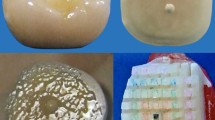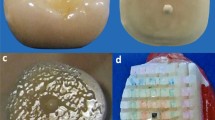Abstract
The aim of this study was to test the effect of different chelating agents on microtensile bond strength (MTBS) of self-adhesive resin cements to dentin. The occlusal surfaces of extracted human mandibular molars (N = 80) were cut horizontally to expose sound dentin. The teeth were randomly divided into four groups (n = 20 per group) and dentin surfaces were conditioned according to one of the following methods: group C: no treatment (control group); group CH: 0.2 % chitosan; group E: 17 % ethylene diamine tetra acetic acid (EDTA) and group P: 25 % polyacrylic acid (PAA). Lithium disilicate glass ceramic (e.max CAD) blocks were cemented to conditioned dentin surfaces with self-adhesive cements (RelyX Unicem or Clearfil SA) and photo-polymerized. Specimens were stored in distilled water at 37 °C for 24 h and thermocycled for 6,000 times. The beams were obtained from bonded ceramic–cement–tooth assemblies and were subjected to the MTBS test (1 mm/min). Failure types were analyzed and selected beams were examined under scanning electron microscope. Data (MPa) were analyzed using two-way ANOVA and Tukey’s test (P < 0.05). While cement type significantly affected the MTBS results (P < 0.05), no significant difference was observed between the dentin chelating agents (P = 0.785). Interaction terms were not significant (P = 0.114). Control group with no dentin conditioning presented significantly lower results with both cements (RelyX Unicem: 8.1 ± 1.9a, Clearfil SA: 8 ± 1.6a) than those of conditioned groups (19.3 ± 4.2b–24.5 ± 5.2b) (P < 0.05). Failure types were predominantly adhesive in all groups. Chitosan (2 %), EDTA (17 %) or PAA (25 %) could all be used as dentin chelating agents in conjunction with self-adhesive resin cements tested.


Similar content being viewed by others
References
Mormann WH. The evolution of the CEREC system. J Am Dent Assoc. 2006;137:7–13.
Frankenberger R, Petschelt A, Kramer N. Leucite reinforced glass ceramic inlays and onlays after 6 years: clinical behavior. Oper Dent. 2000;25:459–65.
Marocho SM, Özcan M, Amaral R, Bottino MA, Valandro LF. Effect of resin cement type on the microtensile bond strength to lithium disilicate ceramic and dentin using different test assemblies. J Adhes Dent. 2013;15:361–8.
Saker S, Ibrahim F, Özcan M. Effect of different surface treatments on adhesion of In-Ceram zirconia to enamel and dentin substrates. J Adhes Dent. 2013;15:369–76.
Passos SP, Kimpara ET, Bottino MA, Júnior GC, Rizkalla AS. Bond strength of different resin cement and ceramic shades bonded to dentin. J Adhes Dent. 2013;15:461–6.
Passos SP, Souza RO, Michida SM, Zamboni SC, de Oliveira SH. Effects of cement-curing mode and light-curing unit on the bond durability of ceramic cemented to dentin. Braz Oral Res. 2013;27:169–75.
Stewart GP, Jain P, Hodges J. Shear bond strength of resin cements to both ceramic and dentin. J Prosthet Dent. 2002;88:277–84.
Nagai T, Kawamoto Y, Kakehashi Y, Matsumura H. Adhesive bonding of a lithium disilicate ceramic material with resin-based luting agents. J Oral Rehabil. 2005;32:598–605.
Simon JF, de Rijk WG, Hill J, Hill N. Tensile bond strength of ceramic crowns to dentin using resin cements. Int J Comput Dent. 2011;14:309–19.
Dalby R, Ellakwa A, Millar B, Martin FE. Influence of immediate dentin sealing on the shear bond strength of pressed ceramic luted to dentin with self-etch resin cement. Int J Dent. 2012;2012:310702–9.
de Castro HL, Passos SP, Zogheib LV, Bona AD. Effect of cement shade and light-curing unit on bond strength of a ceramic cemented to dentin. J Adhes Dent. 2012;14:155–60.
Xie J, Powers JM, McGuckin RS. In vitro bond strength of two adhesives to enamel and dentin under normal and contaminated conditions. Dent Mater. 1993;9:295–9.
Kelsey WP, Latta MA, Blankenau RJ. Effect of provisional restorations on dentin bond strengths of resin cements. Am J Dent. 1998;11:67–70.
Hill EE. Dental cements for definitive luting: A review and practical clinical considerations. Dent Clin North Am. 2007;51:643–58.
Leirskar J, Nordbo H. The effect of zinc oxide-eugenol on the shea bond strength of a commonly used bonding system. Endod Dent Traumatol. 2000;16:265–8.
Grasso C, Caluori D, Goldstein G, Hittelman E. In vivo evaluation of three cleansing techniques for prepared abutment teeth. J Prosth Dent. 2002;88:437–41.
Mair L, Padipatvuthikul P. Variables related to materials and preparing for bond strength testing irrespective of the test protocol. Dent Mater. 2010;26:e17–23.
Sarac D, Sarac YS, Kulunk S, Kulunk T. Effect of the dentin cleansing techniques on dentin wetting and on the bond strength of a resin luting agent. J Prosth Dent. 2005;94:363–9.
Yang B, Ludwig K, Adelung R, Kern M. Micro-tensile bond strength of three luting resins to human regional dentin. Dent Mater. 2006;22:45–56.
Kambara K, Nakajima M, Hosaka K, Takahashi M, Thanatvarakorn O, Ichinose S, et al. Effect of smear layer treatment on dentin bond of self-adhesive cements. Dent Mater. 2012;31:980–7.
Lisboa DS, Santos SV, Griza S, Rodrigues JL, Faria-e-Silva AL. Dentin deproteinization effect on bond strength of self-adhesive resin cements. Braz Oral Res. 2013;27:73–5.
Mazzitelli C, Monticelli F, Toledano M, Ferrari M, Osorio R. Dentin treatment effects on the bonding performance of self-adhesive resin cements. Eur J Oral Sci. 2010;118:80–6.
Di Hipólito V, Rodrigues FP, Piveta FB, AzevedoLda C, Bruschi Alonso RC, Silikas N, et al. Effectiveness of self-adhesive luting cements in bonding to chlorhexidine-treated dentin. Dent Mater. 2012;28:495–501.
Ayad MF, Rosenstiel SF, Hassan MM. Surface roughness of dentin after tooth preparation with different rotary instrumentation. J Prosthet Dent. 1996;75:122–8.
Toledano M, Osorio R, Perdigao J, Rosales JI, Thompson JY, Cabrerizo-Vilchez MA. Effect of acid etching and collagen removal on dentin wettability and roughness. J Biomed Mater Res. 1999;47:198–203.
Hikita K, Van Meerbeek B, De Munck J, Ikeda T, Van Landuyt K, Maida T, et al. Bonding effectiveness of adhesive luting agents to enamel and dentin. Dent Mater. 2007;23:71–80.
Lührs AK, Guhr S, Günay H, Geurtsen W. Shear bond strength of self-adhesive resins compared to resin cements with etch and rinse adhesives to enamel and dentin in vitro. Clin Oral Invest. 2010;14:193–9.
Tonial D, Ghiggi PC, Lise AA, Burnett LH Jr, Oshima HM, Spohr AM. Effect of conditioner on microtensile bond strength of self-adhesive resin cements to dentin. Stomatologija. 2010;12:73–9.
Pavan S, dos Santos PH, Berger S, Bedran-Russo AK. The effect of dentin pretreatment on the microtensile bond strength of self-adhesive resin cements. J Prosthet Dent. 2010;104:258–64.
El-Askary FS, Nassif MS. The effect of the pre-conditioning step on the shear bond strength of nano-filled resin-modified glass-ionomer to dentin. Eur J Dent. 2011;5:150–6.
Ferracane JL, Stansbury JW, Burke FJT. Self-adhesive resin cement-chemistry, properties and clinical considerations. J Oral Rehabil. 2011;38:295–314.
Broyles AC, Pavan S, Bedran-Russo AK. Effect of dentin surface modification on the microtensile bond strength of self-adhesive resin cements. J Prosthodont. 2013;22:59–62.
Silva PV, Guedes DF, Nakadi FV, Pécora JD, Cruz-Filho AM. Chitosan: a new solution for removal of smear layer after root canal instrumentation. Int Endod J. 2013;46:332–8.
Akncbay H, Senel S, Ay ZY. Application of chitosan gel in the treatment of chronic periodontitis. J Biomed Mater Res. Part B, Appl Biomater. 2007;80:290-6.
Peter MG. Applications and environmental aspects of chitin and chitosan. J Macromol Sci. 1995;32:629–40.
DaSilva L, Finer Y, Friedman S, Basrani B, Kishen A. Biofilm formation within the interface of bovine root dentin treated with conjugated chitosan and sealer containing chitosan nanoparticles. J Endod. 2013;39:249–53.
Rinaudo M, Pavlov G, Desbrie`res J. Influence of acetic acid concentration on the solubilization of chitosan. Polymer. 1999;40;7029-32.$.
Silva PV, Guedes DF, Pécora JD, da Cruz-Filho AM. Time-dependent effects of chitosan on dentin structures. Braz Dent J. 2012;23:357–61.
Manuja N, Nagpal R, Pandit IK. Dental adhesion: mechanism, techniques and durability. J Clin Pediatr Dent. 2012;36:223–34.
Hülsmann M, Heckendorff M, Lennon A. Chelating agents is root canal treatment mode of action and indications for their use. Int Endod J. 2003;36:810–30.
Feitosa VP, Sauro S, Watson TF, et al. Evaluation of the micro-mechanical strength of resin bonded–dentin interfaces submitted to short-term degradation strategies. J Mech Behav Biomed Mater. 2012;15:112–20.
ISO TR. Guidance on testing of adhesion to tooth structure. International Organization for Standardization, 1994. 11405, p. 1–14 Geneva (Switzerland).
Rhazi M, Desbrie `res J, Tolaimate A, et al. Influence of the nature of the metal ions on the complexation with chitosan: application to the treatment of liquid waste. Eur Polym J. 2002;38:1523–30.
Pimenta JA, Zaparolli D, Pécora JD, Cruz-Filho AM. Chitosan: effect of a new chelating agent on the microhardness of root dentin. Braz Dent J. 2012;23:212–7.
Sauro S, Mannocci F, Toledano M, Osorio R, Pashley DH, Watson TF. EDTA or H3PO4/NaOCl dentine treatments may increase hybrid layers’ resistance to degradation: a microtensile bond strength and confocal-micropermeability study. J Dent. 2009;37:279–88.
Pashley D. Clinical correlations of dentin structure and function. J Prosthet Dent. 1991;66:777–81.
Conflict of Interest
The authors declare that they have no conflict of interest.
Author information
Authors and Affiliations
Corresponding author
Rights and permissions
About this article
Cite this article
Saker, S., Alnazzawi, A. & Özcan, M. Adhesive strength of self-adhesive resins to lithium disilicate ceramic and dentin: effect of dentin chelating agents. Odontology 104, 53–59 (2016). https://doi.org/10.1007/s10266-014-0180-3
Received:
Accepted:
Published:
Issue Date:
DOI: https://doi.org/10.1007/s10266-014-0180-3




